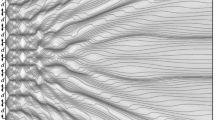Abstract
Physical vacuum is a special superfluid medium populated by enormous amount of virtual particle-antiparticle pairs. Its motion is described by the modified Navier–Stokes equation: (a) the pressure gradient divided by the mass density is replaced by the gradient from the quantum potential; (b) time-averaged the viscosity vanishes, but its variance is not zero. Vortex structures arising in this medium show infinitely long lifetime owing to zero average viscosity. The nonzero variance is conditioned by exchanging the vortex energy with zero-point vacuum fluctuations. The vortex has a non-zero core where the orbital speed vanishes. The speed reaches a maximal value on the core wall and further it decreases monotonically. The vortex trembles around some average value and possesses by infinite life time. The vortex ball resulting from topological transformation of the vortex ring is considered as a model of a particle with spin. Anomalous magnetic moment of electron is computed.










Similar content being viewed by others
Notes
see in Wikipedia: ‘Tropical cyclone’.
The name “vortex ball” originates from the ball lighting—an astonishing electromagnetic bundle of energy emerging often during thunderstorms.
Wikipedia: ’color wheel’.
This is the most accurate value given in Wikipedia: ‘Electron magnetic moment’.
One can guess that the helicoidal vortex rings are similar to strings [20] after reducing them onto the 3D-brane, to our three-dimensional space.
References
Agamalyan, M.M., Drabkin, G.M., Sbitnev, V.I.: Spatial spin resonance of polarized neutrons. A tunable slow neutron filter. Phys. Rep. 168(5), 265–303 (1988). doi:10.1016/0370-1573(88)90081-6
Benseny, A., Albareda, G., Sanz, A.S., Mompart, J., Oriols, X.: Applied Bohmian mechanics. Eur. Phys. J. D 68, 286–328 (2014). doi:10.1140/epjd/e2014-50222-4
Bush, J.W.M.: Pilot-wave hydrodynamics. Annu. Rev. Fluid Mech. 47, 26992 (2015). doi:10.1146/annurev-fluid-010814-014506
de Broglie, L.: Interpretation of quantum mechanics by the double solution theory. Ann. Fond. Louis Brog. 12(4), 1–22 (1987)
Feynman, R.P., Hibbs, A.: Quantum Mechanics and Path Integrals. McGraw Hill, New York (1965)
Kevlahan, N.K.R., Farge, M.: Vorticity filaments in two-dimensional turbulence: creation, stability and effect. J. Fluid Mech. 346(9), 49–76 (1997). doi:10.1017/S0022112097006113
Kundu, P., Cohen, I.: Fluid Mechanics, pp. 92101–94495. Academic Press, San Diego (2002)
Lighthill, M.J.: An Informal Introduction to Theoretical Fluid Mechanics. Oxford University Press, Oxford (1986)
Mandache, N.B.: On the physical origin of the anomalous magnetic moment of electron. arXiv:1307.2063 (2013)
Martins, A.A.: Fluidic electrodynamics: on parallels between electromagnetic and fluidic inertia. arXiv:1202.4611 (2012)
Sbitnev, V.I.: Particle with spin in a magnetic field—the Pauli equation and its splitting into two equations for real functions (in Russian). Quantum Magic 5(2), 2112–2131. http://quantmagic.narod.ru/volumes/VOL522008/p2112.html (2008)
Sbitnev, V.I.: Physical vacuum is a special superfluid medium, chap 12. In: Pahlavani, M.R. (ed.) Selected Topics in Applications of Quantum Mechanics, pp. 345–373. InTech, Rijeka (2015)
Sbitnev, V.I.: Hydrodynamics of the physical vacuum: I. Scalar quantum sector. Found. Phys. 46(5), 606–619 (2016). doi:10.1007/s10701-015-9980-8
Schwinger, J.: On quantum-electrodynamics and the magnetic moment of the electron. Phys. Rev. 73, 416–418 (1948). doi:10.1103/PhysRev.73.416
Sommerfield, C.M.: The magnetic moment of the electron. Ann. Phys. 5(1), 26–57 (1958). doi:10.1016/0003-4916(58)90003-4
Sonin, E.B.: Dynamics of helical vortices and helical-vortex rings. Europhys. Lett. 97, 46002 (2012). doi:10.1209/0295-5075/97/46002
Tryggeson, H.: Analytical Vortex Solutions to the Navier-Stokes Equation. Thesis for the degree of Doctor of Philosophy. Växjö University, Sweden. http://www.diva-portal.org/smash/get/diva2:205082/FULLTEXT01 (2007)
Volovik, G.E.: The Universe in a Helium Droplet. Oxford University Press, Oxford (2003)
Wu, J.-Z., Ma, H.-Y., Zhou, M.D.: Vorticity and Vortex Dynamics. Springer, Heidelberg (2006)
Yau, S.T., Nadis, S.: The Shape of Inner Space. String Theory and the Geometry of the Universe’s Hidden Dimensions. Basic Books, New York (2010)
Acknowledgments
The author thanks Denise Puglia, Mike Cavedon, and Pat Noland for useful and valuable remarks and offers. The author thanks also the reviewers for the constructive critique and proposals.
Author information
Authors and Affiliations
Corresponding author
Rights and permissions
About this article
Cite this article
Sbitnev, V.I. Hydrodynamics of the Physical Vacuum: II. Vorticity Dynamics. Found Phys 46, 1238–1252 (2016). https://doi.org/10.1007/s10701-015-9985-3
Received:
Accepted:
Published:
Issue Date:
DOI: https://doi.org/10.1007/s10701-015-9985-3



